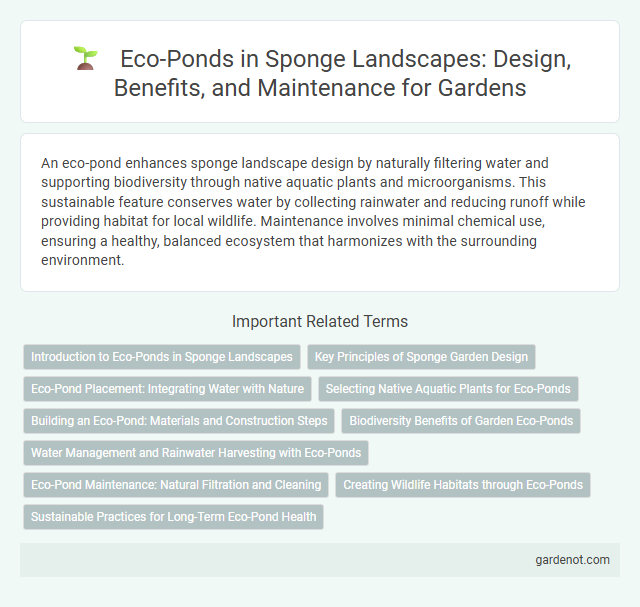An eco-pond enhances sponge landscape design by naturally filtering water and supporting biodiversity through native aquatic plants and microorganisms. This sustainable feature conserves water by collecting rainwater and reducing runoff while providing habitat for local wildlife. Maintenance involves minimal chemical use, ensuring a healthy, balanced ecosystem that harmonizes with the surrounding environment.
Introduction to Eco-Ponds in Sponge Landscapes
Eco-ponds in sponge landscapes function as natural water retention and filtration systems, enhancing groundwater recharge and mitigating urban flooding. They support diverse aquatic ecosystems while improving water quality by capturing runoff and filtering pollutants through native vegetation. Integrating eco-ponds contributes to sustainable stormwater management and promotes ecological balance within urban and suburban environments.
Key Principles of Sponge Garden Design
Eco-ponds in sponge gardens prioritize permeable soil layers, native aquatic plants, and strategic water catchment zones to enhance natural water absorption and retention. The integration of biofiltration using wetland vegetation improves water quality while supporting local biodiversity. Careful contouring of the landscape directs rainwater efficiently into the pond, reducing runoff and promoting groundwater recharge.
Eco-Pond Placement: Integrating Water with Nature
Eco-pond placement enhances sponge landscape effectiveness by strategically integrating water retention within natural topography, promoting groundwater recharge and reducing surface runoff. Positioning eco-ponds in low-lying areas or natural depressions maximizes water absorption, supporting native vegetation and biodiversity. This careful integration fosters sustainable water management, mitigating flood risks while maintaining ecosystem balance.
Selecting Native Aquatic Plants for Eco-Ponds
Selecting native aquatic plants for eco-ponds enhances biodiversity, supports local wildlife, and improves water filtration. Species such as cattails, water lilies, and arrowheads are well-adapted to local conditions, ensuring sustainability and reducing maintenance. These plants stabilize pond ecosystems by preventing erosion, providing habitat, and balancing nutrient cycles naturally.
Building an Eco-Pond: Materials and Construction Steps
Building an eco-pond begins with selecting porous, natural materials such as clay, sand, and gravel to ensure optimal water retention and filtration. Layering these materials strategically supports a balanced ecosystem, promotes biodiversity, and prevents water stagnation. Careful excavation, lining with biodegradable membranes, and incorporating native aquatic plants are crucial construction steps to maintain the pond's ecological function and sustainability.
Biodiversity Benefits of Garden Eco-Ponds
Garden eco-ponds enhance local biodiversity by providing habitats for amphibians, insects, and aquatic plants, promoting ecosystem balance. These sustainable water features support pollinators and natural pest controllers, contributing to healthier gardens. By integrating native flora and improving water quality, eco-ponds foster resilient, thriving microhabitats within urban landscapes.
Water Management and Rainwater Harvesting with Eco-Ponds
Eco-ponds serve as sustainable water management systems by capturing and storing rainwater, reducing runoff, and replenishing groundwater reserves. These natural reservoirs help mitigate flooding while providing habitat for aquatic life and improving water quality through sedimentation and biofiltration. Implementing eco-ponds in sponge landscapes enhances rainwater harvesting efficiency and supports urban resilience against climate change impacts.
Eco-Pond Maintenance: Natural Filtration and Cleaning
Eco-pond maintenance relies on natural filtration systems that use aquatic plants, beneficial bacteria, and porous substrates to break down organic waste and maintain water clarity. Regular monitoring of water quality parameters such as pH, dissolved oxygen, and nutrient levels is essential to support the biological balance within the pond. Implementing a diverse ecosystem with algae-eating fish and periodic removal of excess vegetation helps prevent sediment buildup and promotes a healthy, self-sustaining aquatic environment.
Creating Wildlife Habitats through Eco-Ponds
Eco-ponds enhance biodiversity by providing essential habitats for amphibians, insects, and birds, supporting local ecosystems within sponge landscapes. These carefully designed water bodies use natural filtration systems and native vegetation to maintain water quality and promote sustainable wildlife populations. Integrating eco-ponds in sponge landscapes fosters resilient habitats that contribute to ecological balance and boost species diversity.
Sustainable Practices for Long-Term Eco-Pond Health
Eco-ponds utilize biofiltration systems and native aquatic plants to naturally purify water and maintain balanced ecosystems, reducing the need for chemical treatments. Incorporating rainwater harvesting and permeable surfaces within sponge landscape design enhances groundwater recharge and minimizes water runoff. Regular monitoring of water quality parameters like pH, dissolved oxygen, and nutrient levels supports the sustainable management and longevity of eco-pond habitats.
Eco-pond Infographic

 gardenot.com
gardenot.com